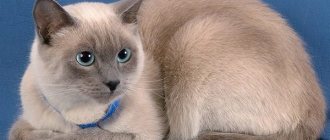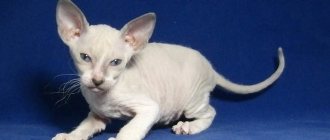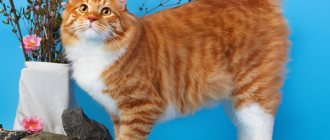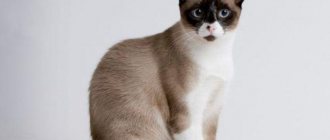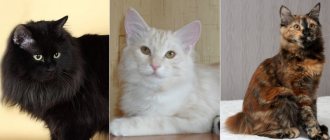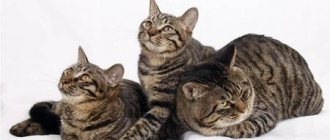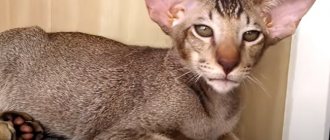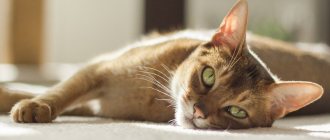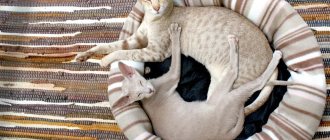The Tonkinese cat, which combines an expressive appearance and a reasonable character, was simply bound to attract attention and acquire admirers in Russia, but this has not happened yet.
The breed, widespread in America and some European countries, has not found a large number of fans in our country, which greatly upsets its few breeders and connoisseurs. Probably, the lack of popularity is explained by the fact that the breed is still young and little known.
Origin story
The history of the birth of Tonkinese cats is surprising in that felinologists from two different countries came up with the same idea at the same time: to breed a new breed of the Burmese type, but with stronger bones and more hardiness. They even took the same cats for this purpose: Burmese and Siamese.
The kittens turned out to be simply charming: slender, with amazingly silky fur and large turquoise eyes. At first they were called golden Siamese, but a little later they were renamed the Tonkinese cat.
The cat did not get this name out of the blue. At that time, a musical about the love of a Vietnamese girl and an American soldier, who had been separated by an evil fate for a long time, was extremely popular in the United States. The place where the main events took place was the town of Tonkin.
This breed is recognized by almost all felinological organizations, but it is most popular in the USA and Canada.
How to name
Today, the choice of nickname for your pet is varied. The owner makes his own decision based on the appearance, habits and character of the animal.
Names for boys
The most popular nicknames for male kittens will be: Anubis, Cupid, Bushui, Barsik, Belyash, Vaska, Murchik, Boris, Thomas, Ginger. The owner makes the choice, and any nickname will suit the kitten.
Nicknames for girls
They try to call Tonkinese cat girls original, catchy and elegant. The most common nicknames: Brunhilda, Bastinda, Mark, Claire, Klepa, Princess, Matilda.
There are many nicknames, so choosing the right one is not difficult.
The Tonkinese cat is a beautiful, friendly, playful pet, distinguished by its easy-going nature, easygoing nature and the ability to get along with any people and animals. Proper care and attention can make the Tonkinese a true and devoted friend to the whole family.
Standards
The Tonkinese is a medium-sized cat, very elegantly built, with long thin legs and an elongated muzzle. At first glance it seems very light, but underneath the apparent fragility hides strong muscles and the habits of an active animal. The average weight of a female is 2.5-3.5 kg, males can reach 5 kg.
| Standard | Description |
| Head | Wedge-shaped, with smooth features without sharp corners. High cheekbones, a strong chin and protruding whisker pads are clearly defined. |
| Eyes | Almond-shaped, large, the color of the iris is turquoise or aquamarine of varying degrees of brightness. |
| Ears | Small, erect, widely spaced relative to each other. Their tips are rounded. |
| Torso | It does not give the impression of being stocky or squat; on the contrary, it seems light and proportional. |
| Limbs | The forelimbs are slightly shorter than the hind limbs, but this does not affect the gait. The paws are medium-sized, oval, with thin, graceful toes. |
| Tail | Long, medium thickness, pointed at the tip. |
| Wool | The coat fits tightly to the body, it is soft and short. There is no undercoat. |
Significant shortcomings due to which the animal is removed from the competition are:
- Tail with kinks or loops;
- White spots on the body;
- Yellow eyes;
- Aggression or unfriendly behavior towards a person.
Psychology
According to the observations of breeders, these cats combine only the best traits from their ancestors.
They incredibly love the attention of their owners, their warmth and affection.
As soon as the owner or members of his family are on the threshold of the house, these representatives of the feline family will certainly be nearby.
Compared to Chartreuse, Tonkinese are more talkative.
They will not miss the opportunity to remind you of themselves. But still, these pets are not as loud as, for example, orientals .
Interesting! Tonkinese people really do not like conflicts in the family and immediately sense if there is a tense situation. The cat will try to soften the conflict atmosphere by any means.
Has the owner arrived?
Guests will not be a worry, because Tonkinese cats will immediately play with children.
They get along well with other animals, be it different breeds of dogs , ferrets , and even chameleons and geckos .
From the very first months of life, kittens try to find an approach to each family member.
They behave playfully and kindly with every person.
Colors
Tonkinese cats have 3 recognized point color options (mink, Burmese and classic color point) and several color options. All of them are registered in systems (WCF, CFA).
The following are considered acceptable:
- Mink (natural) – the fur has a warm brown shade with spots the color of dark chocolate;
- Champagne – light beige fur, light brown markings;
- Platinum mink – light gray wool color with dark markings;
- Blue mink has blue fur with bluish markings.
The chest, belly and inside of the paws are always a little lighter, the back shines as if covered with gloss. There is no pattern (with the exception of very young animals, which may have some kind of transparent pattern).
In the photo there is a Tonkinese cat (Tonkinese) of popular colors: blue mink, natural and champagne.
The TICA system allows other coat colors: tortoiseshell, apricot with a dash of cream.
Intelligence
Tonkinese are very intelligent and easy to train. They have an excellent memory, thanks to which they can remember the intonation of their owner’s voice and even remember some words.
They are also playful and do not disdain, like other cats, to fetch a ball. They love it when the owner is involved in the game.
As mentioned earlier, this breed is highly trainable. However, the reward must be given immediately so that it is easier for the pet to associate it with performing the trick. The same is true when an animal misbehaves: it is enough to punish it once and it will immediately understand what not to do.
Character and behavior
Don't be alarmed by the presence of Siamese cats in your family: Tonkinese cats have not adopted the tough temperament of their wayward ancestors. But there is more than enough kindness and friendliness in them. Very calm, attentive, friendly cats will fit perfectly into any family, will obediently obey the rules of the new home and try to help their owner in all his affairs. These are real mini-companions: the most interesting thing for them is to watch a person and try to participate in all his affairs. But at the same time they are absolutely devoid of intrusiveness and touchiness.
Subtly sensing the mood of the leader, the Tonkinese will not get under his feet during periods of irritation, but will watch from afar and come only at the right time.
They get along well with children, even very small ones, and patiently endure children’s whims, but if a child causes him pain, he will run away and hide from him in the future.
He prefers to be friends with his relatives, and also with dogs. He will make friends with smaller creatures - birds and rodents if he grew up with them. However, he does not have a hunting instinct, but, wanting to play with a tiny mouse, he may accidentally injure it. So it's better not to take risks.
He loves to communicate with a person using sounds, but does it quietly, without annoying him with uncontrollable meowing for many hours.
Loneliness for him is a time of melancholy and sadness. He will not tear up furniture or destroy everything around as a sign of protest, but he will refuse games and food, lie down on the windowsill and wait for the person he loves. If your job requires frequent absences from home, get not one, but two Tonkinese cats.
Name the cat who always wanted to live together
BasilioLeopold
Tonkinese treat strangers with sympathy and quickly find a “common language” with them. They are not afraid of noisy human gatherings; on the contrary, they try to get into the very thick of the crowd, sniffing everyone and everyone.
They quickly remember new information, so teaching them to use a scratching post, litter box, and walk on a harness is not difficult.
Unfortunately, in our country there are no nurseries that would breed Tonkinese cats. There are no such nurseries in neighboring countries, and even in Europe they are absent. Therefore, the search for a kitten can turn into a difficult quest, which only the most stubborn, passionately in love with this breed, can complete. There are 2 options: either you go directly to the USA or Canada to get it, or you negotiate with a private person who does it for you (you can talk about this topic with the owner of a Siamese nursery).
Purchasing a Tonkinese kitten
It is better to buy a Tonkinese kitten from breeders who have permanent nurseries, because due to the external resemblance to Siamese cats, they may sell you an animal of a different breed.
When choosing a kitten, you need to pay attention to the following parameters:
- pedigree or metrics;
- vaccinations;
- veterinary passport;
- healthy pure breed parents;
- purchase and sale agreements.
Pets are sold no older than 3 months and must be litter box trained and may have preferences for certain foods. Therefore, when receiving a kitten, it is necessary to clarify its habits and, if possible, collect food samples and a small piece of used litter so that the kitten can immediately find a toilet in its new home.
In the first days after acquisition, for a comfortable adaptation, the kitten will need maximum care and attention from its new owners.
The cost of an animal is around 30 thousand rubles and depends on the location of the nursery and compliance with breed standards.
Care instructions
For cats with long, thick hair, the issue of caring for it is always difficult. The owner has to regularly devote several hours a week to the combing procedure. Buy special brushes, care sprays, and spend a lot of time cleaning.
Wool
With Tonkinese cats everything is much simpler. Since the undercoat is completely absent and the outer coat is very short, the shedding process does not irritate either the animal or its owner. All you have to do is brush your cat once a week, then remove excess fur with wet hands - and the job is done.
Bathing
They do not like to swim, so arrange your water schedule in such a way as to stress your pet as little as possible.
If it gets very dirty after walking down the street, it should, of course, be washed. But if the cat stays at home, you shouldn’t put him in the bath every week. Once every 4 months will be enough.
Teeth
Problems with teeth in Tonkinese dogs arise, alas, often, so don’t leave things to chance: teach him, while still a kitten, to brush his teeth weekly, drop a special gel (to remove plaque) into the drinking water, let him chew on cleaning pads from time to time, and Once a year (or more often, as the veterinarian advises), take your animal to the clinic for teeth cleaning. This procedure is carried out under general anesthesia, it is inexpensive, and the benefits are quite noticeable.
Ears
Cats' ears are cleaned once a week by soaking a cotton swab in boiled water and removing wax and dust from the sink. You cannot reach deep into the ear and drop anything there: the eardrum is easily damaged, and the liquid provokes otitis media.
Claws
The Tonkinese will deal with its claws on its own: just show it where the scratching post is, and your furry clever girl will not encroach on either your leather sofas or your dear wallpaper.
Remember that now kittens born from Siamese and Burmese are not considered Teonkinesis! A purebred animal is considered to be the one that appears as a result of the mating of Tonkinese parents (both of them, not just one of them).
Breeding
In 2001, the breed lost its hybrid status, i.e. individuals are mated only within the breed; matings of Burmese and Siamese cats are no longer registered in most systems or are registered after consideration of the need for such crossing.
Childbirth in cats usually occurs without complications. On average, a Tonkinese cat gives birth to 5-6 kittens, but a record of 19 kittens has been recorded. According to reviews from Tonkinese owners, four-legged parents raise kittens together - the cat helps the cat as much as possible in caring for the babies.
All kittens, regardless of the intended color, are born lighter than their parents - not a single breeder or owner can determine the color of a kitten by eye immediately after birth.
In one litter, half of the kittens are born of the Tonkinese type, the other half are divided into kittens of the Siamese and Burmese types. Kittens of the Tonkinese type are selected for exhibitions; Siamese and Burmese are usually sold as a pet class - they participate in breeding in exceptional cases. Breeders are trying to remove dark points from the breed, striving for a uniform light brown mink.
Catering
The Tonkinese cat is not picky, but the peculiarity of its digestion is such that the food from our table is absolutely not suitable for it. Fatty soups, porridge generously seasoned with butter, fried meat, smoked meats and the like cause irreparable harm to the health of the animal.
Natural products
Prohibited products include the following:
- Alcohol (poisoning, irritation of the gastrointestinal tract);
- Chocolate and cocoa products (theobromine in the composition is toxic, causes increased heart rate, hyperactivity, diarrhea, vomiting, death);
- Tea, coffee (hyperactivity, diseases of the nervous and cardiovascular systems);
- Beer (hops lead to seizures and increased heart rate);
- Avocados, eggplants, garlic, onions, tomatoes, rhubarb, legumes, fruit seeds, grapes, raisins, citrus fruits, persimmons, nuts, mushrooms (cause irritation of the stomach, intestines, toxic shock, destroy red blood cells);
- Whole cow's milk (fed for babies, but in adult cats it causes diarrhea);
- Raw eggs (risk of salmonella infection, vitamin B deficiency);
- Pork, duck, goose, wild bird meat (undercooked and raw - a source of tapeworms, but boiled too hard for the stomach);
- Bones (get stuck in the throat, damage the mucous membrane, and can pierce the stomach);
- Lard, pieces of fatty meat (cause pancreatitis);
- Human vitamins and dog food (toxic);
- Smoked, salty, fried, sweet, pickled (stomach upset, metabolic failure);
- Products with mold and expired.
You should be careful with pasta, bread and pastries.
Adult cats are fed 2 times a day, kittens 3-6 times.
It is allowed to include in the diet:
- Meat: beef, veal, rabbit, turkey, lamb. Raw meat has a higher energy value, but first it should be frozen for 2-3 days, and before feeding it should be scalded with boiling water to destroy possible pathogens.
- By-products: chicken heads and necks; ventricles, kidneys, hearts. Be sure to include cartilage in your diet, but avoid skin and paws.
- Eggs are a source of protein, but you should not feed them raw eggs - your cat can get E. coli. They are boiled and only the yolk is given from chicken, and the whole from quail.
- Fish - with a minimum of bones and preferably sea, low-fat.
- Dairy products: sour cream, yogurt, cottage cheese, bio-yogurt, hard unsalted cheese, fermented baked milk.
- Vegetables: pumpkin, beets, zucchini, carrots, green salad, dill, parsley, broccoli. Vegetables can be given raw, but it is better to boil them and, finely chop them, mix with porridge.
- Porridge: rice, oatmeal, buckwheat, millet. Porridge is cooked not with milk, but with water, without sugar or salt.
- Clean water, purified by filter or settled.
Expert opinion
Dusheba Vera Ivanovna
In 2010, she graduated from the Moscow State Academy of Veterinary Medicine named after K.I. Scriabin with honors, specializing in veterinary medicine. I regularly attend veterinary conferences, congresses, and webinars.
In the wild, a cat gets rid of fur in its stomach by finding and eating a certain type of grass. At home you will have to grow it yourself, but there is nothing difficult about it. Buy oat or wheat grains and plant them in a convenient container on the windowsill. The cat will eat it itself when needed.
Recommended food
If it is more convenient for you to feed your cat ready-made food: choose holistic food. They are considered the best that exist today, because they are made from high-quality products, the composition is perfectly balanced and rich in both vitamins and minerals.
Below are the recommended holistic and super-premium foods. Links with the names of the food are clickable, on them you can, within our website, get acquainted with the descriptions of the food and read reviews from the owners of Tonkinese (Tonkinese) cats.
| Holistic | Holistic | Super premium |
| Holistic Blend | Superpet | Bravery |
Diseases
Despite their external fragility, Tonkinese dogs have strong immunity. But he could not avoid hereditary diseases (and the fault was that of a distant Siamese ancestor). Moreover, unfortunately, there are many of these diseases.
Liver amyloidosis is a disorder of protein metabolism. It is diagnosed both in young and old age, and in females more often than in males. Symptoms: renal failure, weight loss, lethargy, thirst, vomiting, ascites, edema, yellowness of the skin and mucous membranes. It cannot be cured, but medications allow you to maintain a decent standard of living.
Gingivitis is an inflammation of the gums that occurs due to poor hygiene and a weakened immune system. The gums turn red, the mouth smells unpleasant, saliva flows in abundance, and the cat eats little.
Methods of treatment: medication, folk remedies (as maintenance therapy: irrigating the oral cavity with a decoction of oak bark, chamomile, lubricating the gums with sea buckthorn oil), removal of damaged teeth.
Strabismus (strabismus) - can be congenital or acquired (cause: tumor, injury, diseases of the nervous system). Treatment: conservative or surgical.
Asthma is a chronic disease that is almost impossible to get rid of. Causes: breed, infectious and viral diseases, frequent stress, allergens (smoke, pollen, dust, chemicals, parasites living on the skin). Seasonality, like with people, is present. Regular intake of medications and adherence to certain rules in the home (frequent cleaning of the apartment, humidification of the air, balanced nutrition, use of hypoallergenic cosmetics) help improve the quality of life.
Cats of this breed do not tolerate anesthesia very well (doctors cannot yet determine exactly what this is due to). In addition, they have weak upper respiratory tracts (which means there is a high risk of colds) and very delicate stomachs).
Expert opinion
Dusheba Vera Ivanovna
In 2010, she graduated from the Moscow State Academy of Veterinary Medicine named after K.I. Scriabin with honors, specializing in veterinary medicine. I regularly attend veterinary conferences, congresses, and webinars.
Even if your cat does not go outside, she still needs to be vaccinated (against rabies, rhinotracheitis, calcivirus, panleukopenia) every year, and given an anthelmintic once a quarter.
Photo gallery
In the photos below there is a Tonkinese cat (the second name is Tonkinese.
